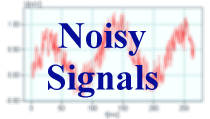| Fundamentals of Statistics contains material of various lectures and courses of H. Lohninger on statistics, data analysis and chemometrics......click here for more. |

|

Home  General Processing Steps General Processing Steps  Data Preprocessing Data Preprocessing  Signal and Noise Signal and Noise |
|
| See also: Types of Noise, origin of noise, time averaging, Coefficient of Variation | |
Signal and NoiseAny value obtained by a measurement contains two components: one carries the information of interest, the signal, the other consists of random errors, or noise, that is superimposed on the first component. These random errors are, of course, unwanted because they diminish the accuracy and precision of the measurement.
Noise free data can never be realized in practice since some types of noise are the result of thermodynamic and quantum effects that cannot be avoided during a measurement. But measurements produced from non-electronic devices are also contaminated with random errors. Signal processing aims at extracting information from the raw signal. The difficulty in reaching this goal depends both on the characteristics of the noise-free signal and the noise. The signal-to-noise-ratio (SNR) is the ratio of the strength of the signal and the strength of the noise. The higher the ratio the easier it is to extract information and the more reliable are the results. In analytical chemistry the SNR is one of the figures of merit that describes the quality of a particular analysis technique. There are two methods of calculating the SNR. The first one defines the SNR as the ratio of the mean and the standard deviation of the measured signal.
SNR = When the signal is a transient one (e.g. a chromatographic peak), then we use the ratio of the mean around the maximum and the standard deviation of the measured signal:
SNR = The second method, which is mainly used in the field of electronics, the SNR is calculated as the ratio of the power of the signal Psignal to the power of the noise Pnoise: SNR = Psignal / Pnoise = (Vsignal / Vnoise)2, where the voltage V is the RMS voltage (root mean square voltage). The signal to noise ratio can be improved by repeating a measurement several times and summing up the results. The SNR improves with the square root of the number of repetitions (see section on time averaging for more details).
|
|
Home  General Processing Steps General Processing Steps  Data Preprocessing Data Preprocessing  Signal and Noise Signal and Noise |
|



 / s
/ s